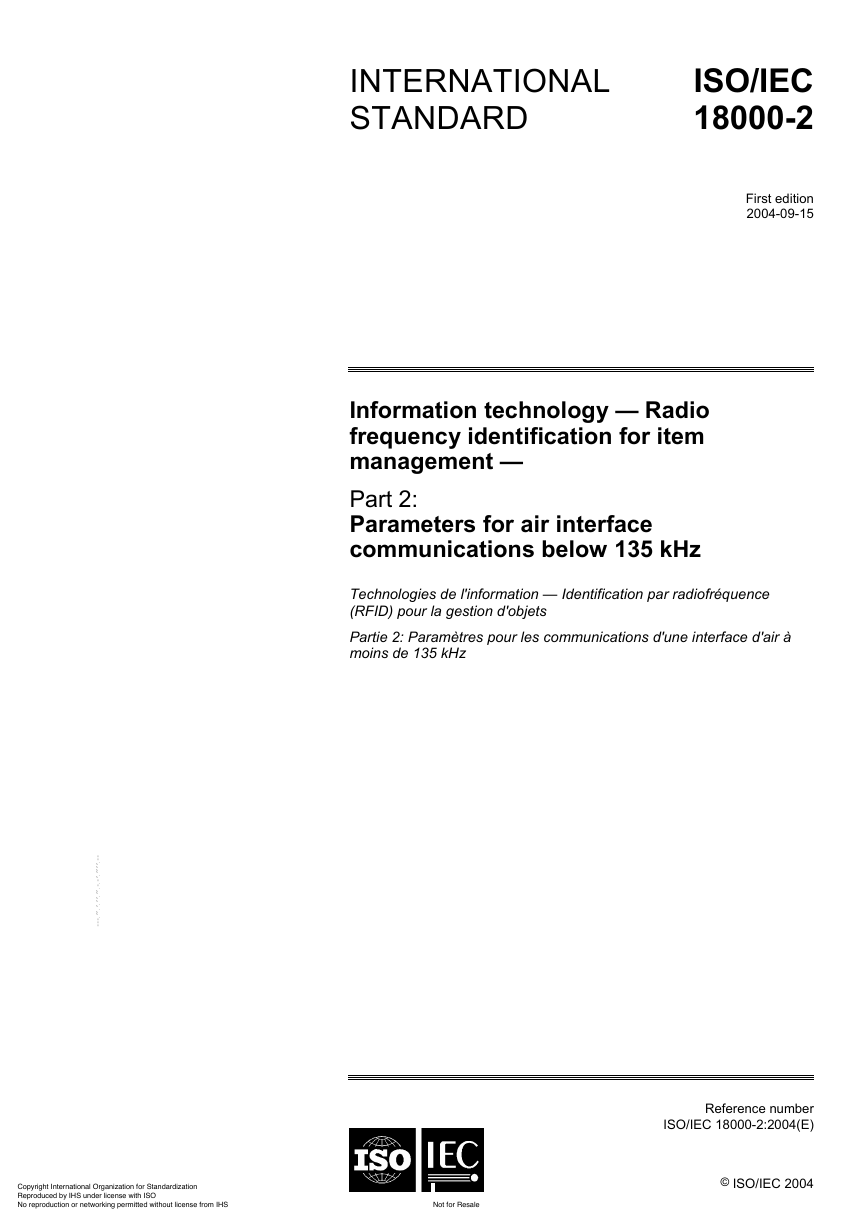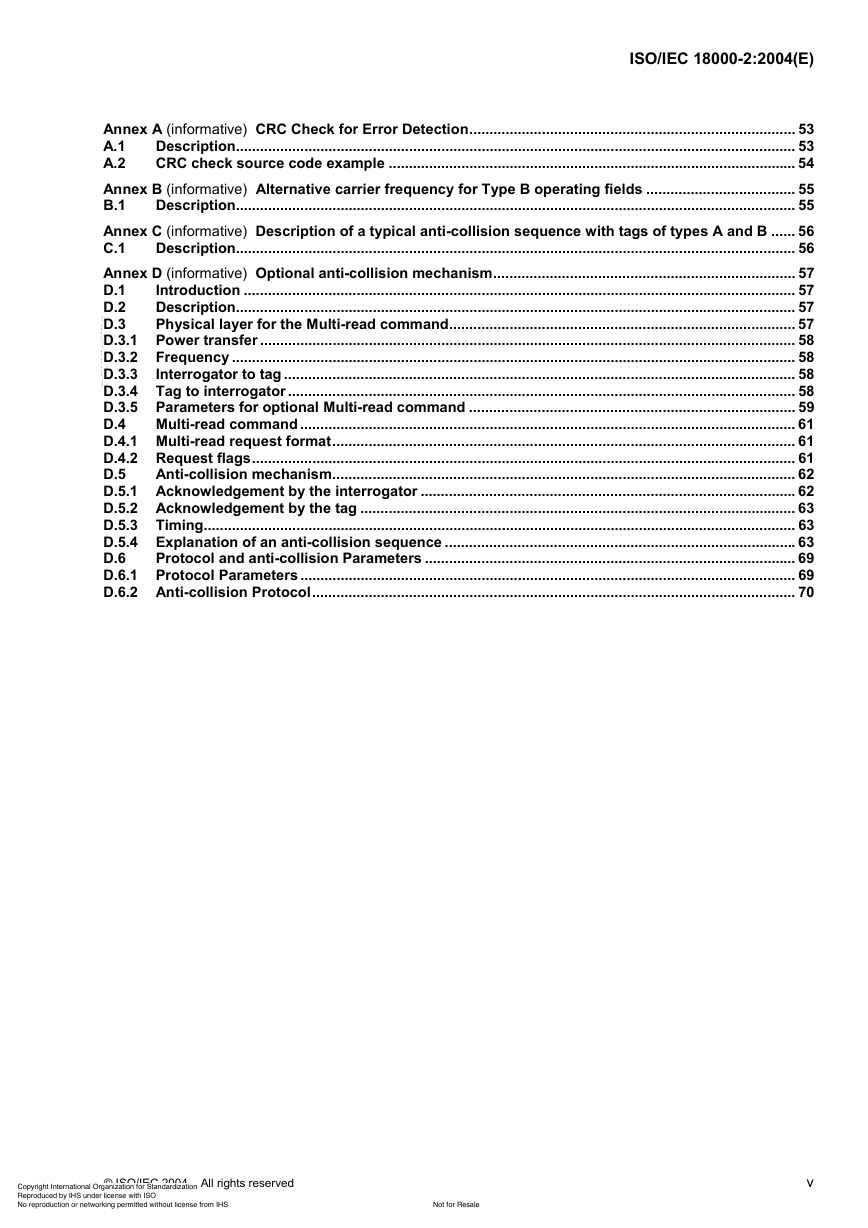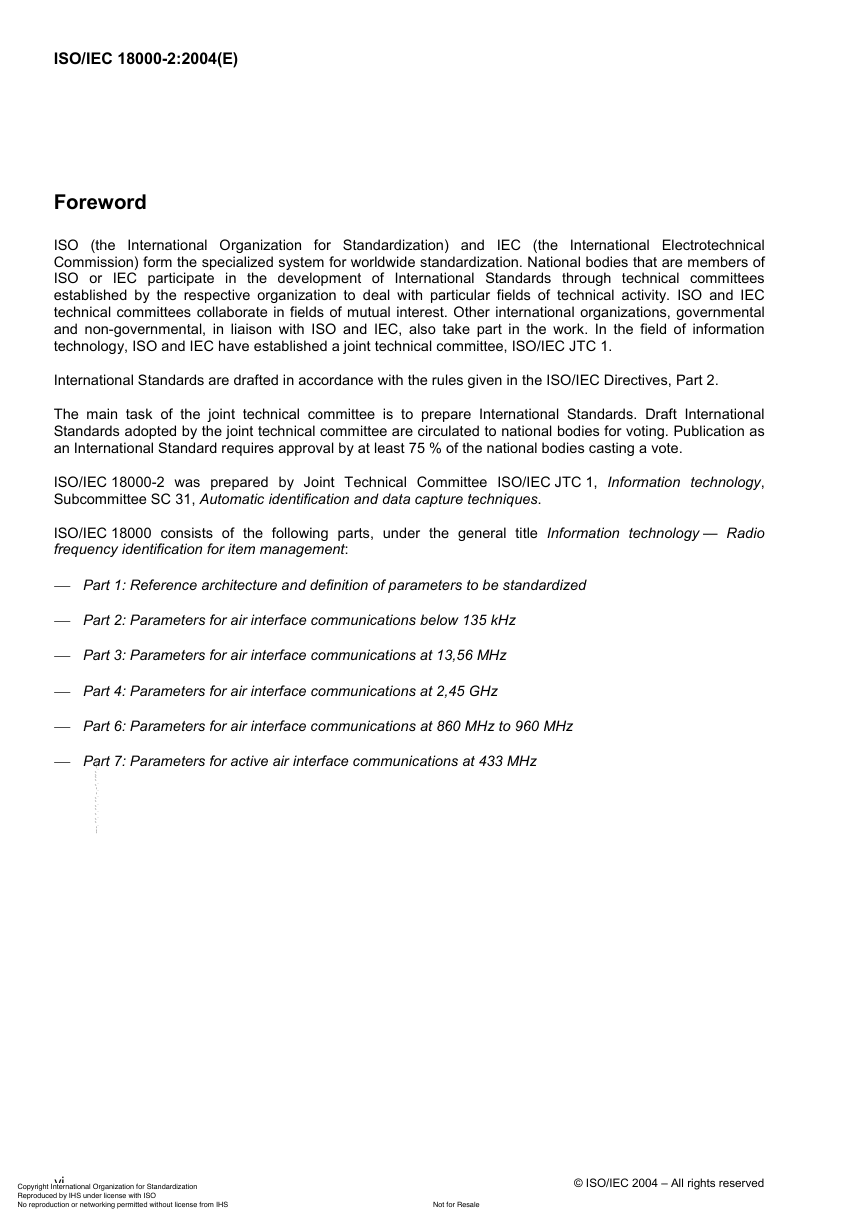INTERNATIONAL
STANDARD
ISO/IEC
18000-2
First edition
2004-09-15
Information technology — Radio
frequency identification for item
management —
Part 2:
Parameters for air interface
communications below 135 kHz
Technologies de l'information — Identification par radiofréquence
(RFID) pour la gestion d'objets
Partie 2: Paramètres pour les communications d'une interface d'air à
moins de 135 kHz
Reference number
ISO/IEC 18000-2:2004(E)
© ISO/IEC 2004
Copyright International Organization for Standardization Reproduced by IHS under license with ISO Not for ResaleNo reproduction or networking permitted without license from IHS--`,,,,`,-`-`,,`,,`,`,,`---�
ISO/IEC 18000-2:2004(E)
PDF disclaimer
This PDF file may contain embedded typefaces. In accordance with Adobe's licensing policy, this file may be printed or viewed but
shall not be edited unless the typefaces which are embedded are licensed to and installed on the computer performing the editing. In
downloading this file, parties accept therein the responsibility of not infringing Adobe's licensing policy. The ISO Central Secretariat
accepts no liability in this area.
Adobe is a trademark of Adobe Systems Incorporated.
Details of the software products used to create this PDF file can be found in the General Info relative to the file; the PDF-creation
parameters were optimized for printing. Every care has been taken to ensure that the file is suitable for use by ISO member bodies. In
the unlikely event that a problem relating to it is found, please inform the Central Secretariat at the address given below.
© ISO/IEC 2004
All rights reserved. Unless otherwise specified, no part of this publication may be reproduced or utilized in any form or by any means,
electronic or mechanical, including photocopying and microfilm, without permission in writing from either ISO at the address below or
ISO's member body in the country of the requester.
ISO copyright office
Case postale 56 • CH-1211 Geneva 20
Tel. + 41 22 749 01 11
Fax + 41 22 749 09 47
E-mail copyright@iso.org
Web www.iso.org
Published in Switzerland
ii
© ISO/IEC 2004 – All rights reserved
Copyright International Organization for Standardization Reproduced by IHS under license with ISO Not for ResaleNo reproduction or networking permitted without license from IHS--`,,,,`,-`-`,,`,,`,`,,`---�
ISO/IEC 18000-2:2004(E)
Contents
Page
Foreword............................................................................................................................................................ vi
Introduction ...................................................................................................................................................... vii
Scope...................................................................................................................................................... 1
1
2
Conformance ......................................................................................................................................... 1
Tag.......................................................................................................................................................... 1
2.1
Interrogator............................................................................................................................................ 2
2.2
Normative references ........................................................................................................................... 2
3
4
Terms, definitions, symbols and abbreviated terms......................................................................... 2
Terms and definitions........................................................................................................................... 2
4.1
Symbols ................................................................................................................................................. 3
4.2
4.3
Abbreviated terms................................................................................................................................. 3
5
Physical layer ........................................................................................................................................ 4
5.1
Type A (FDX).......................................................................................................................................... 4
5.1.1 Power transfer ....................................................................................................................................... 4
5.1.2 Frequency .............................................................................................................................................. 4
5.1.3 Communication signal interface interrogator to tag ......................................................................... 4
5.1.4 Communication signal interface tag to interrogator ......................................................................... 6
5.2
Type B (HDX) ......................................................................................................................................... 7
5.2.1 Power transfer ....................................................................................................................................... 7
5.2.2 Communication signal interface interrogator to tag ......................................................................... 7
5.2.3 Communication signal interface tag to interrogator ....................................................................... 10
5.3
Physical and Media Access Control (MAC) Parameters ................................................................. 11
5.3.1
Interrogator to tag link........................................................................................................................ 11
5.3.2 Tag to interrogator link....................................................................................................................... 14
Transmission Protocol ....................................................................................................................... 16
6
6.1
Basic elements .................................................................................................................................... 16
6.2
Unique identifier.................................................................................................................................. 16
6.2.1 Unique identifier (UID) ........................................................................................................................ 16
6.2.2 Sub-UID ................................................................................................................................................ 17
Request format.................................................................................................................................... 18
6.3
6.4
Response format................................................................................................................................. 18
6.5
Request flags....................................................................................................................................... 19
6.5.1 AFI flag ................................................................................................................................................. 20
6.5.2 NOS flag ............................................................................................................................................... 20
6.5.3 SEL flag and ADR flag ........................................................................................................................ 20
6.5.4 CRCT flag............................................................................................................................................. 20
6.5.5 PEXT flag.............................................................................................................................................. 21
Error flag .............................................................................................................................................. 21
6.6
Block security status .......................................................................................................................... 21
6.7
6.8
AFI security status .............................................................................................................................. 22
6.9
DSFID security status ......................................................................................................................... 22
6.10
Start of frame pattern (SOF)............................................................................................................... 22
6.10.1 Interrogator request............................................................................................................................ 22
6.10.2 Tag response....................................................................................................................................... 22
6.11
End of frame pattern (EOF) ................................................................................................................ 23
6.11.1 Interrogator request............................................................................................................................ 23
6.11.2 Tag response....................................................................................................................................... 23
6.12 CRC....................................................................................................................................................... 23
6.13 Application family identifier (AFI)...................................................................................................... 23
© ISO/IEC 2004 – All rights reserved
iii
Copyright International Organization for Standardization Reproduced by IHS under license with ISO Not for ResaleNo reproduction or networking permitted without license from IHS--`,,,,`,-`-`,,`,,`,`,,`---�
ISO/IEC 18000-2:2004(E)
6.14 Data storage format identifier (DSFID)..............................................................................................25
User memory organisation.................................................................................................................25
7
8
Tag states.............................................................................................................................................25
Power-off state.....................................................................................................................................25
8.1
Ready state ..........................................................................................................................................25
8.2
Quiet state ............................................................................................................................................25
8.3
8.4
Selected state ......................................................................................................................................26
8.5
State diagram.......................................................................................................................................26
Anti-collision........................................................................................................................................27
9
9.1
Request parameters............................................................................................................................27
9.2
Request processing by the tag..........................................................................................................27
9.3
Explanation of anti-collision sequences...........................................................................................30
9.3.1 Anti-collision sequence with 1 slot ...................................................................................................30
9.3.2 Anti-collision sequence with 16 slots ...............................................................................................30
9.3.3 Mixed population with tags of type A and B.....................................................................................32
10
Commands ...........................................................................................................................................32
10.1 Command classification .....................................................................................................................32
10.1.1 Mandatory commands ........................................................................................................................32
10.1.2 Optional commands............................................................................................................................32
10.1.3 Custom commands .............................................................................................................................32
10.1.4 Proprietary commands .......................................................................................................................32
10.2 Command code structure...................................................................................................................33
10.3 Command list.......................................................................................................................................34
10.4 Mandatory commands ........................................................................................................................34
10.4.1 INVENTORY..........................................................................................................................................34
10.4.2 STAY QUIET .........................................................................................................................................36
10.5 Optional commands............................................................................................................................36
10.5.1 READ SINGLE BLOCK ........................................................................................................................36
10.5.2 READ SINGLE BLOCK WITH SECURITY STATUS ...........................................................................36
10.5.3 READ MULTIPLE BLOCKS .................................................................................................................37
10.5.4 READ MULTIPLE BLOCKS WITH SECURITY STATUS....................................................................38
10.5.5 WRITE SINGLE BLOCK.......................................................................................................................39
10.5.6 WRITE MULTIPLE BLOCKS................................................................................................................39
10.5.7 LOCK BLOCK.......................................................................................................................................40
10.5.8 GET SYSTEM INFORMATION.............................................................................................................41
10.5.9 SELECT ................................................................................................................................................42
10.5.10 RESET TO READY...............................................................................................................................43
10.5.11 WRITE SYSTEM DATA ........................................................................................................................43
10.5.12 LOCK SYSTEM DATA .........................................................................................................................44
10.5.13 Optional command execution in inventory mode............................................................................45
10.6 Custom commands .............................................................................................................................46
10.7
Proprietary commands .......................................................................................................................46
11
Protocol timing specifications...........................................................................................................46
11.1
Type A (FDX) ........................................................................................................................................47
11.1.1 Tag waiting time before transmitting its response after reception of an EOF from the
interrogator ..........................................................................................................................................47
11.1.2 Interrogator waiting time before sending a subsequent request...................................................47
11.1.3 Interrogator waiting time before switching to the next slot during an inventory process..........48
11.2
Type B (HDX)........................................................................................................................................49
11.2.1 Tag waiting time before transmitting its response after reception of an EOF from the
interrogator ..........................................................................................................................................49
11.2.2 Interrogator waiting time before sending a subsequent request...................................................49
11.2.3 Interrogator waiting time before switching to the next slot during an inventory process..........49
11.2.4 Tag charge and re-charge ..................................................................................................................50
Protocol parameters............................................................................................................................50
12
13
Anti-collision parameters ...................................................................................................................51
iv
© ISO/IEC 2004 – All rights reserved
Copyright International Organization for Standardization Reproduced by IHS under license with ISO Not for ResaleNo reproduction or networking permitted without license from IHS--`,,,,`,-`-`,,`,,`,`,,`---�
ISO/IEC 18000-2:2004(E)
Annex A (informative) CRC Check for Error Detection................................................................................. 53
A.1
Description........................................................................................................................................... 53
A.2
CRC check source code example ..................................................................................................... 54
Annex B (informative) Alternative carrier frequency for Type B operating fields ..................................... 55
B.1
Description........................................................................................................................................... 55
Annex C (informative) Description of a typical anti-collision sequence with tags of types A and B ...... 56
C.1
Description........................................................................................................................................... 56
Annex D (informative) Optional anti-collision mechanism........................................................................... 57
Introduction ......................................................................................................................................... 57
D.1
D.2
Description........................................................................................................................................... 57
D.3
Physical layer for the Multi-read command...................................................................................... 57
D.3.1 Power transfer ..................................................................................................................................... 58
D.3.2 Frequency ............................................................................................................................................ 58
D.3.3
Interrogator to tag ............................................................................................................................... 58
D.3.4 Tag to interrogator .............................................................................................................................. 58
D.3.5 Parameters for optional Multi-read command ................................................................................. 59
D.4
Multi-read command ........................................................................................................................... 61
D.4.1 Multi-read request format................................................................................................................... 61
D.4.2 Request flags....................................................................................................................................... 61
D.5
Anti-collision mechanism................................................................................................................... 62
D.5.1 Acknowledgement by the interrogator ............................................................................................. 62
D.5.2 Acknowledgement by the tag ............................................................................................................ 63
D.5.3 Timing................................................................................................................................................... 63
D.5.4 Explanation of an anti-collision sequence ....................................................................................... 63
D.6
Protocol and anti-collision Parameters ............................................................................................ 69
D.6.1 Protocol Parameters ........................................................................................................................... 69
D.6.2 Anti-collision Protocol........................................................................................................................ 70
© ISO/IEC 2004 – All rights reserved
v
Copyright International Organization for Standardization Reproduced by IHS under license with ISO Not for ResaleNo reproduction or networking permitted without license from IHS--`,,,,`,-`-`,,`,,`,`,,`---�
ISO/IEC 18000-2:2004(E)
Foreword
ISO (the International Organization for Standardization) and IEC (the International Electrotechnical
Commission) form the specialized system for worldwide standardization. National bodies that are members of
ISO or IEC participate in the development of International Standards through technical committees
established by the respective organization to deal with particular fields of technical activity. ISO and IEC
technical committees collaborate in fields of mutual interest. Other international organizations, governmental
and non-governmental, in liaison with ISO and IEC, also take part in the work. In the field of information
technology, ISO and IEC have established a joint technical committee, ISO/IEC JTC 1.
International Standards are drafted in accordance with the rules given in the ISO/IEC Directives, Part 2.
The main task of the joint technical committee is to prepare International Standards. Draft International
Standards adopted by the joint technical committee are circulated to national bodies for voting. Publication as
an International Standard requires approval by at least 75 % of the national bodies casting a vote.
ISO/IEC 18000-2 was prepared by Joint Technical Committee ISO/IEC JTC 1, Information technology,
Subcommittee SC 31, Automatic identification and data capture techniques.
ISO/IEC 18000 consists of the following parts, under the general title Information technology — Radio
frequency identification for item management:
Part 1: Reference architecture and definition of parameters to be standardized
Part 2: Parameters for air interface communications below 135 kHz
Part 3: Parameters for air interface communications at 13,56 MHz
Part 4: Parameters for air interface communications at 2,45 GHz
Part 6: Parameters for air interface communications at 860 MHz to 960 MHz
Part 7: Parameters for active air interface communications at 433 MHz
vi
© ISO/IEC 2004 – All rights reserved
Copyright International Organization for Standardization Reproduced by IHS under license with ISO Not for ResaleNo reproduction or networking permitted without license from IHS--`,,,,`,-`-`,,`,,`,`,,`---�
ISO/IEC 18000-2:2004(E)
Introduction
ISO/IEC 18000 is a series of International Standards describing common communications protocols for the
purpose of Radio Frequency Identification for Item Management.
This part of ISO/IEC 18000 relates to systems operating at frequencies less than 135 kHz.
It has been developed in accordance with the requirements determined in ISO 18000-1, Information
technology — Radio frequency identification for item management — Reference architecture and definition of
parameters to be standardized.
The International Organization for Standardization (ISO) and International Electrotechnical Commission (IEC)
draw attention to the fact that it is claimed that compliance with this document may involve the use of patents
concerning radio-frequency identification technology given in the table below.
ISO and IEC take no position concerning the evidence, validity and scope of these patent rights.
The holders of these patent rights have assured the ISO and IEC that they are willing to negotiate licences
under reasonable and non-discriminatory terms and conditions with applicants throughout the world. In this
respect, the statements of the holders of these patent rights are registered with ISO and IEC.
Information may be obtained from:
Contact details
Patent number
US 5286955
EP 0502518B1
US 6002344
ATMEL
Dr. Bertram Koch
Leiter Patentabteilung OP31
ATMEL Germany GmbH
Theresienstrasse 2
D-74072 Heilbronn
Germany
Tel: +49-7131-67-3254
Fax: +49-7131-67-2789
bertram.koch@hno.atmel.com
Matrics Technology
Mr Kevin J Powell
Senior Director, Product Development
8850 Stanford Blvd, Suite 3000
Columbia, MD 21045
USA
Tel: +1-410-872-0300
Fax +1-443-782-0230
kpowell@matrics.com
Koninklijke Philips Electronics N.V
Mr.Harald Röggla
Intellectual Property & Standards
Triester Strasse 64
A-1101 Vienna
Austria
harald.roeggla@philips.com
AT-PS 401127, CN 1293789-A
EP 1064616A, JP 00-596516
US 09/487151, WO 00/45328-A1
EP 0473569B, JP A91-211035
US 5345231B, AT-PS 395224
US 2002-0131453-A1
WO 02/073511
© ISO/IEC 2004 – All rights reserved
vii
Copyright International Organization for Standardization Reproduced by IHS under license with ISO Not for ResaleNo reproduction or networking permitted without license from IHS--`,,,,`,-`-`,,`,,`,`,,`---�
ISO/IEC 18000-2:2004(E)
Contact details
Patent number
US 5426423, EP 90909459.1
CA 2058 947, US 6177858B1
EP 96402556.3, CA 2191787
US 5923251, EP 96402554.8
CA 21911788, US 5808550
EP 96402555.5, CA 2191794
EP 845751, US 5793324
US 5929801, US 5053774
INTERCODE / SPACECODE
12, Rue des Petits Ruisseaux
Z.I. des Godets
F-91370 Verrières le Buisson
France
Tel: + 33.1.69.75.21.70
Fax: + 33.1.60.11.00.31
intercode.sarl@wanadoo.fr
Texas Instruments Inc.
Mr. Russ Baumann
S&C Patent & Legal Counsel
34 Forest Street
Attleboro, MA
USA
Tel: +1 508-236-3314
Fax: +1 508-236-1960
rbaumann@ti.com
Attention is drawn to the possibility that some of the elements of this document may be the subject of patent
rights other than those identified above. ISO and IEC shall not be held responsible for identifying any or all
such patent rights.
viii
© ISO/IEC 2004 – All rights reserved
Copyright International Organization for Standardization Reproduced by IHS under license with ISO Not for ResaleNo reproduction or networking permitted without license from IHS--`,,,,`,-`-`,,`,,`,`,,`---�
















 2023年江西萍乡中考道德与法治真题及答案.doc
2023年江西萍乡中考道德与法治真题及答案.doc 2012年重庆南川中考生物真题及答案.doc
2012年重庆南川中考生物真题及答案.doc 2013年江西师范大学地理学综合及文艺理论基础考研真题.doc
2013年江西师范大学地理学综合及文艺理论基础考研真题.doc 2020年四川甘孜小升初语文真题及答案I卷.doc
2020年四川甘孜小升初语文真题及答案I卷.doc 2020年注册岩土工程师专业基础考试真题及答案.doc
2020年注册岩土工程师专业基础考试真题及答案.doc 2023-2024学年福建省厦门市九年级上学期数学月考试题及答案.doc
2023-2024学年福建省厦门市九年级上学期数学月考试题及答案.doc 2021-2022学年辽宁省沈阳市大东区九年级上学期语文期末试题及答案.doc
2021-2022学年辽宁省沈阳市大东区九年级上学期语文期末试题及答案.doc 2022-2023学年北京东城区初三第一学期物理期末试卷及答案.doc
2022-2023学年北京东城区初三第一学期物理期末试卷及答案.doc 2018上半年江西教师资格初中地理学科知识与教学能力真题及答案.doc
2018上半年江西教师资格初中地理学科知识与教学能力真题及答案.doc 2012年河北国家公务员申论考试真题及答案-省级.doc
2012年河北国家公务员申论考试真题及答案-省级.doc 2020-2021学年江苏省扬州市江都区邵樊片九年级上学期数学第一次质量检测试题及答案.doc
2020-2021学年江苏省扬州市江都区邵樊片九年级上学期数学第一次质量检测试题及答案.doc 2022下半年黑龙江教师资格证中学综合素质真题及答案.doc
2022下半年黑龙江教师资格证中学综合素质真题及答案.doc